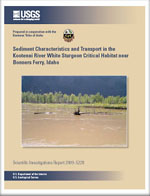Recovery efforts for the endangered Kootenai River population of white sturgeon require an understanding of the characteristics and transport of suspended and bedload sediment in the critical habitat reach of the river. In 2007 and 2008, the U.S. Geological Survey in cooperation with the Kootenai Tribe of Idaho, conducted suspended- and bedload-sediment sampling in the federally designated critical habitat of the endangered Kootenai River white sturgeon population. Three sediment-sampling sites were selected that represent the hydraulic differences in the critical habitat. Suspended- and bedload-sediment samples along with acoustic Doppler current profiles were collected at these sites during specific river discharges. Samples were analyzed to determine suspended- and bedload-sediment characteristics and transport rates. Sediment transport data were analyzed to provide total loading estimates for suspended and bedload sediment in the critical habitat reach.
Total suspended-sediment discharge primarily occurred as fine material that moved through the system in suspension. Total suspended-sediment discharge ranged from about 300 metric tons per day to more than 23,000 metric tons per day. Total suspended sediment remained nearly equal throughout the critical habitat, with the exception of a few cases where mass wasting of the banks may have caused sporadic spikes in total suspended sediment.
Bedload-sediment discharge averaged 0-3 percent of the total loading. These bedload discharges ranged from 0 to 271 tons per day. The bedload discharge in the upper part of the critical habitat primarily consisted of fine to coarse gravel. A decrease in river competence in addition to an armored channel may be the cause of this limited bedload discharge. The bedload discharge in the middle part of the white sturgeon critical habitat varied greatly, depending on the extent of the backwater from Kootenay Lake. A large quantity of fine-to-coarse gravel is present in the braided reach, but the duration of transport for these gravels is limited by the encroaching backwater of Kootenay Lake. Bedload discharge in the lower part of the white sturgeon critical habitat primarily consisted of fine to coarse sand due to decreased velocities as a result of the backwater from Kootenay Lake.


